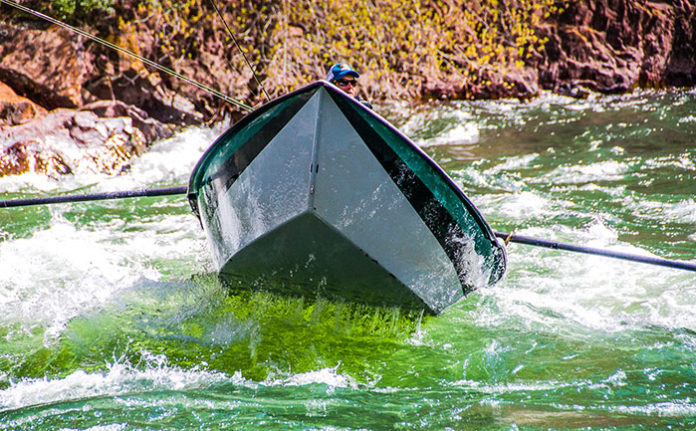Written by: Spencer Durrant
High water presents anglers with plenty of challenges, whether you’re fishing from a boat or wading.
Photo by Ryan Kelly
From the Colorado River drainage to the Snake, western rivers can be high, muddy, and a pain to fish in springtime. If you know where clean water is, you keep it close to your vest. However, every guide and outfitter will tell you the same thing: the key to successfully fishing in high water is the right technique.
Fishing high water can be trying and frustrating. And raging rivers are not as conducive to dry-fly fishing, as we’d all like, but it’s the price we pay to keep the West from drying up.
No matter where you are in the country, you’re likely experiencing some high water, as well. Here are some tips to help you deal with high water and make the most of your days on the river.

One of the hallmarks of an eddy or slow water is foam, and you’ll often find fish there.
Photo by Ryan Kelly
Better Off Dead
Dead water is your best friend this time of year. Trout evolved through periods of higher water than this year, and instinct tells them to stack up in dead water.
You want to fish eddies, slacks, and the slow edges of seams. Riffles are a no-go in high water because staying in them requires more energy than trout can consume. Dead water requires very little energy to swim in, and it’s also an area of the river where a good chunk of the food will collect.
Throwing a streamer into dead water and making short, concise strips is a great way to fish high water this time of year. A big, meaty nymph under an indicator is a good choice, too.
Keep the Tip High
This is something I’ve noticed is a huge problem for me this year: Higher water creates more and stronger currents, and as any dry fly fisherman knows, those topwater currents make for challenging drifts. This is the time to use a longer leader and heavier weight-forward line. High-stick your flies to keep as much line off the water as possible. It’s a different approach, especially when you’re dry-fly fishing, but it’s what I’ve found works for me on the days I’ve found fish nosing up to the surface.
Love the Pockets
I was born and bred in the Rockies. The family stream (my ancestors settled the area and the town closest to the stream is named after them) is largely pocket water, and every backcountry angler is familiar with the tumbling, quick-strike nature of pocket water.
High water creates some new pockets while eliminating others, but in the pockets that do exist you’ll find fish. A dry-dropper rig is my favorite way to fish through pocket water, and when the rivers are this high I just lengthen the dropper and make sure the nymph has a tungsten bead.

The soft water next to the main current is a great place to look for high-water trout.
Photo by Ryan Kelly
Dry-Dropper-Dropper
I like to fish three flies when the law allows. Here in Utah, I can get away with it, and in a few other Western states, as well. (Always check your local regulations.) During high water, fish are largely socked in on the bottom of the river. Some, though, will be suspended at different areas in the water column, which is why you’ll want to fish at different depths simultaneously.
Fishing three flies also allows for the following:
- Better strike detection: Strike indicators are great, but when the water is this deep you’ll miss a ton of bites if you’re only staring at the indicator. Long leaders and complex currents means there’s often a delay between the moment a fish bites your fly and when you see the take. Replacing that indicator with a dry fly – less friction on the water and a more direct connection to your nymphs below – increases your ability to detect takes.
- Mimicking the variety of bugs: High water pushes tons of bugs into holes in the same way it pushes fish. Throwing three bugs together will mimic the general crush of insects.
Go out and play in the high water this spring, and put these tips to the test. Just remember – if you can’t catch a certain fish, the problem is always that it’s an impossible drift.
Spencer is a fly fishing writer, outdoors columnist, novelist, and sports writer from Utah. He’s also the managing editor of Spencer Durrant Outdoors and host of the Unhooked podcast. Connect with him on Twitter/Instagram, @Spencer_Durrant.
Credit: Source link































